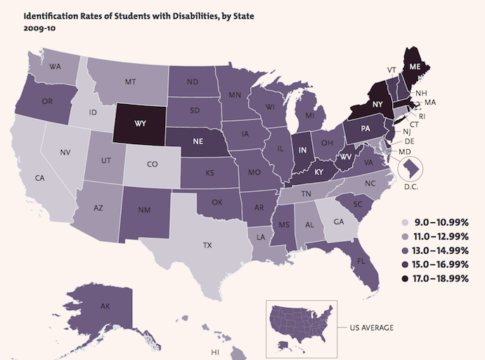America’s approach to the education of children with disabilities is antiquated, costly, and ineffective. “Special education” as we know it is broken—and repainting the surface won’t repair it. It cries out for a radical overhaul. Far too many children emerge from our special-ed system without the skills, knowledge, and competencies that they need for a successful life that fully capitalizes on their abilities. This ineffectual system is also very, very expensive. Yet for a host of reasons—inertia, timidity, political gridlock, fear of litigation, fear of interest groups, ignorance, lack of imagination, and so on—neither our education leaders nor our policy leaders have shown any inclination to modernize it. Instead, they settle for “paint jobs”—waivers and the like.
Federal policy is responsible for much of this failure. Even though the education world has changed around it—as have technology, mobility, fiscal conditions, demographics, and so much more—it remains essentially stuck where it was in 1975 when the first major national law in this realm (now known as the Individuals With Disabilities Education Act or IDEA) was passed.
It was much needed at the time. Many children with disabilities (in those days they were called “handicapped”) had been denied education or given versions of it wholly unsuited to their needs and unlikely to do them much good. Some adults believed that such kids could not learn. Schools in many cases did not know how to educate them well. And few states or districts had focused on the problem.
So Congress did—and President Ford signed the bill, albeit with misgivings. (His “signing statement” presciently declared that “[T]his bill promises more than the federal government can deliver, and its good intentions could be thwarted by the many unwise provisions it contains.”)
The federal program is input-driven, rule-bound, compliance-obsessed, and inattentive to learning outcomes. It is sorely out of touch with an era oriented to academic standards and achievement, to giving families quality choices among good schools, to intervening in unsuccessful schools, and to individualizing every student’s education, often with the help of technology. It is also essentially limitless when it comes to the costs to be incurred by states and districts following this law.
Yes, it cries out for a radical overhaul. And yet it does not prevent states from putting into place some practices and strategies that work better than others. Bear in mind that states and districts account for the lion’s share of special-education funding and that this part of their education budgets has ballooned in recent decades, both because the special-ed pupil rolls have swelled and because costs in this realm are exceptionally difficult to keep within bounds (in part because of federal “cost-may-not-be-considered” and “maintenance-of-effort” rules).
Adding to the costs and further complicating the picture is the subset of disabled students who need very extensive services, sometimes costing hundreds of thousands of dollars each year for each such pupil. Without appropriate planning, meeting their needs can over-stretch district budgets, especially in smaller jurisdictions (and free-standing schools such as charters), putting pressure on the education of other children, causing fiscal distress, and giving rise to political discord.
A new paper from Fordham’s Daniela Fairchild and Matt Richmond, Financing the Education of High-Need Students, does not purport to revamp national special-education policy or to solve all of its financial problems. Instead, it focuses on three specific challenges that are often encountered when districts, especially small districts, grapple with the costs of their highest-need special-education students, and it makes three recommendations that districts and states could put into practice today, without waiting for reforms or help from Washington, as they seek ways to mitigate those problems:
1. District Cooperatives: Many districts—including charter schools, which often comprise their own mini-districts—do not have the requisite size and capacity to serve high-need students effectively and affordably. Multi-district co-ops allow for both economies of scale and better service delivery for these children.
2. Student Funding Based on Multiple Weights: Special-ed funding systems based on average student needs may be easily administered, but they can also lead to inefficient and ineffective resource allocations. Weighted student funding is a tiered system of resource allocation that allows for a more rational and efficacious distribution of funds, enabling districts with more high-need pupils (or pupils who require more dollars to pay for their IEP-mandated services) to receive more money while jurisdictions that need less receive less. Basing those weights on services needed by children rather than disability diagnoses significantly improves the accuracy of this system.
3. Exceptional-Need Funds: Districts (especially small ones) sometimes find themselves overwhelmed by the high cost of educating one or two particularly needy children. This type of fund, managed and predominantly financed by the state, acts as an insurance mechanism for districts that can’t cover the full cost of educating high-need pupils along with all others under their purview.
Let’s say it again: Special education is in need of a top-to-bottom makeover that nobody seems willing or able to undertake. But some worthy repairs can be made around the periphery of current policy—and the three set forth in our new paper are well worth undertaking by states and districts across the land.
-Chester E. Finn, Jr.
This first appeared in the Fordham Institute’s Education Gadfly .




